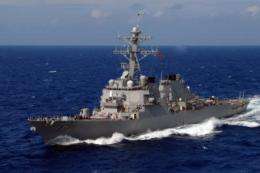ONR demonstrates new counter-mine technology for ships

In a time of increasing irregular warfare threats, the Navy has devised and successfully demonstrated a revolutionary technology to help reduce the risk of naval mine strikes to U.S. Navy ships.
Installed aboard the USS Higgins (DDG 76) in July 2008, the prototype degaussing coil counters underwater mines utilizing superconducting ceramic materials, instead of traditional copper cables, to neutralize the magnetic signature of the ship.
Developed by the Office of Naval Research (ONR) and the Naval Surface Warfare Center Carderock Division (NSWCCD) Ship Engineering Station Philadelphia, the high temperature superconducting (HTS) degaussing coil produced a "full coil effect" April 1 as the Higgins completed a pass over the U.S. Navy Magnetic Silencing Range in San Diego California. This was the first-ever measurement of an HTS degaussing loop installed on a naval combatant.
"We were pleased to have been selected as a test platform," said Cmdr. Carl W. Meuser, USS Higgins commanding officer. "The benefits of HTS degaussing will give us a great warfighting advantage going forward. This technology has a myriad of potential applications that will help make our U.S. Navy even more prepared to conduct prompt and sustained naval operations."
In short, a future the HTS degaussing coil system can act like a cloaking device to eliminate the magnetic signature of the ship, interfering with undersea mines' ability to detect and detonate when a large magnetic field - like the one created by a ship - comes within close proximity.
"As on land, mines at sea remain a lingering threat long after they are deployed," said George Stimak, ONR's lead program manager for HTS degaussing. "Finding better ways to mitigate the threat of naval mines is something the whole program team takes a lot pride in because we know our work will save lives. HTS degaussing technology will provide new options to the naval architect in designing future advanced degaussing systems."
Naval mine strikes are the root cause of 77 percent of U.S. Navy ship casualties occurring since 1950. Most recently, the modern warships USS Samuel B. Roberts, USS Princeton (CG-59) and USS Tripoli (LPH-10) were severely damaged by mine warfare during Persian Gulf conflicts. With increased operations in the coastal areas (or littorals) of the world's oceans, U.S. Navy ships potentially face an increasing threat from naval mines.
"The HTS coil is made of ceramic material that replaces the old copper coils," said Brian Fitzpatrick, an engineer working from NSWCCD Philadelphia. "The super conductivity of this new degaussing system means less energy is required, yet it enables greater degaussing performance. Additionally, there is significant weight savings - up to 80 percent in some cases."
HTS coils, cooled by a cryogenic compressor to nearly minus 400 degrees Fahrenheit, can be operated at current densities that are a factor of 100 to 200 times higher than that of room temperature conductors. This allows the magnetic flux generation from the degaussing loop to be generated at a fraction of the weight of room temperature legacy copper wire systems.
"The demonstration of a rugged and reliable HTS degaussing coil is a true milestone," said Michael D. Riley, degaussing warrant holder for the U.S. Navy. "HTS degaussing coils will give the ship designer the ability to lower the weight and size of the degaussing system with all the advantages that entails."
The HTS degaussing systems projected for ship classes with advanced degaussing systems show an estimated 50 to 80 percent reduction in total system weight, which offers significant potential for fuel savings, or options to add different payloads.
"None of this is possible without our partners," Stimak says. "The support from the USS Higgins, Naval Station San Diego and the Magnetic Silencing Range has been invaluable, as well as all the developmental support from NAVSEA and industry."
Source: Office of Naval Research















